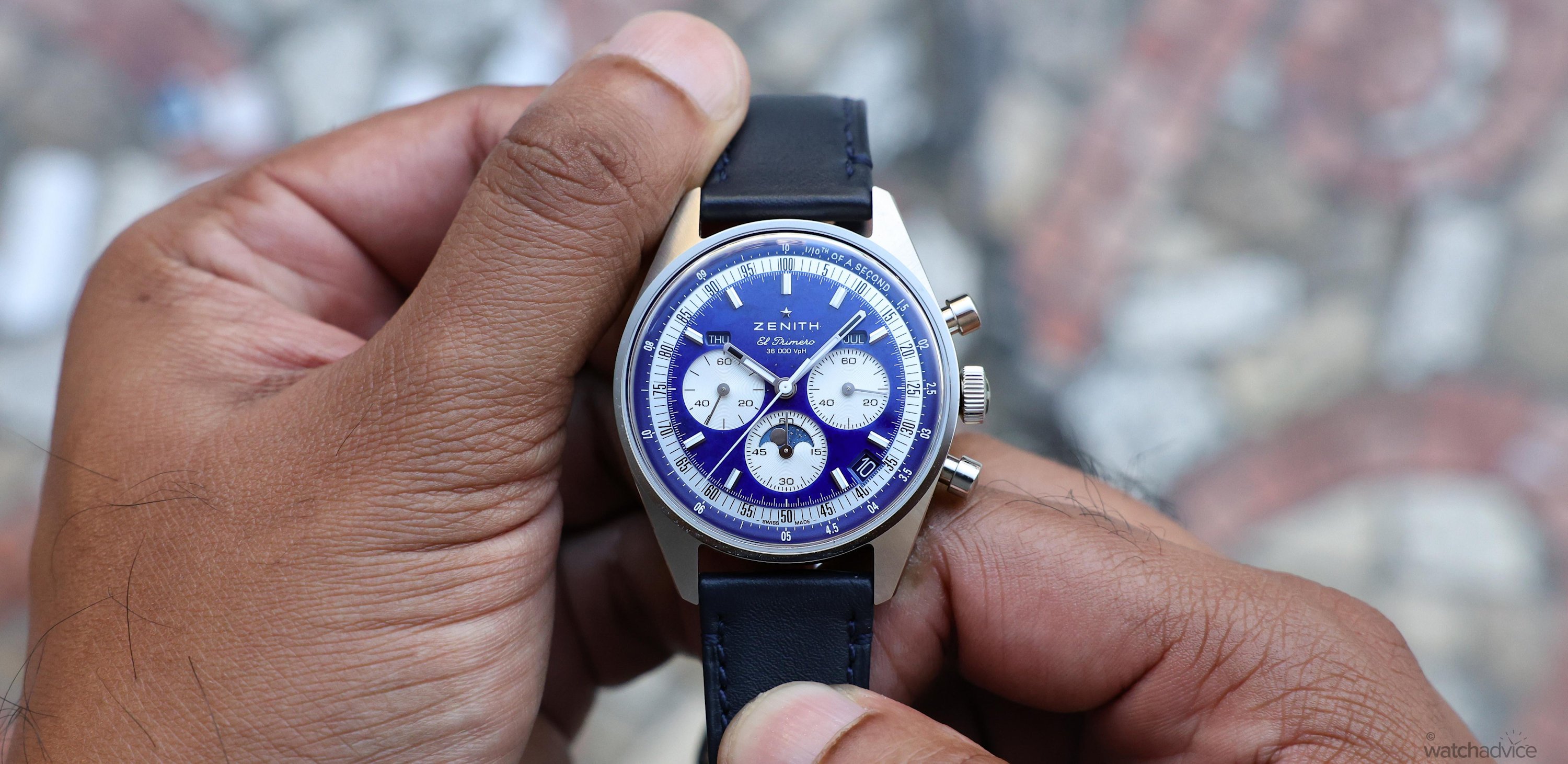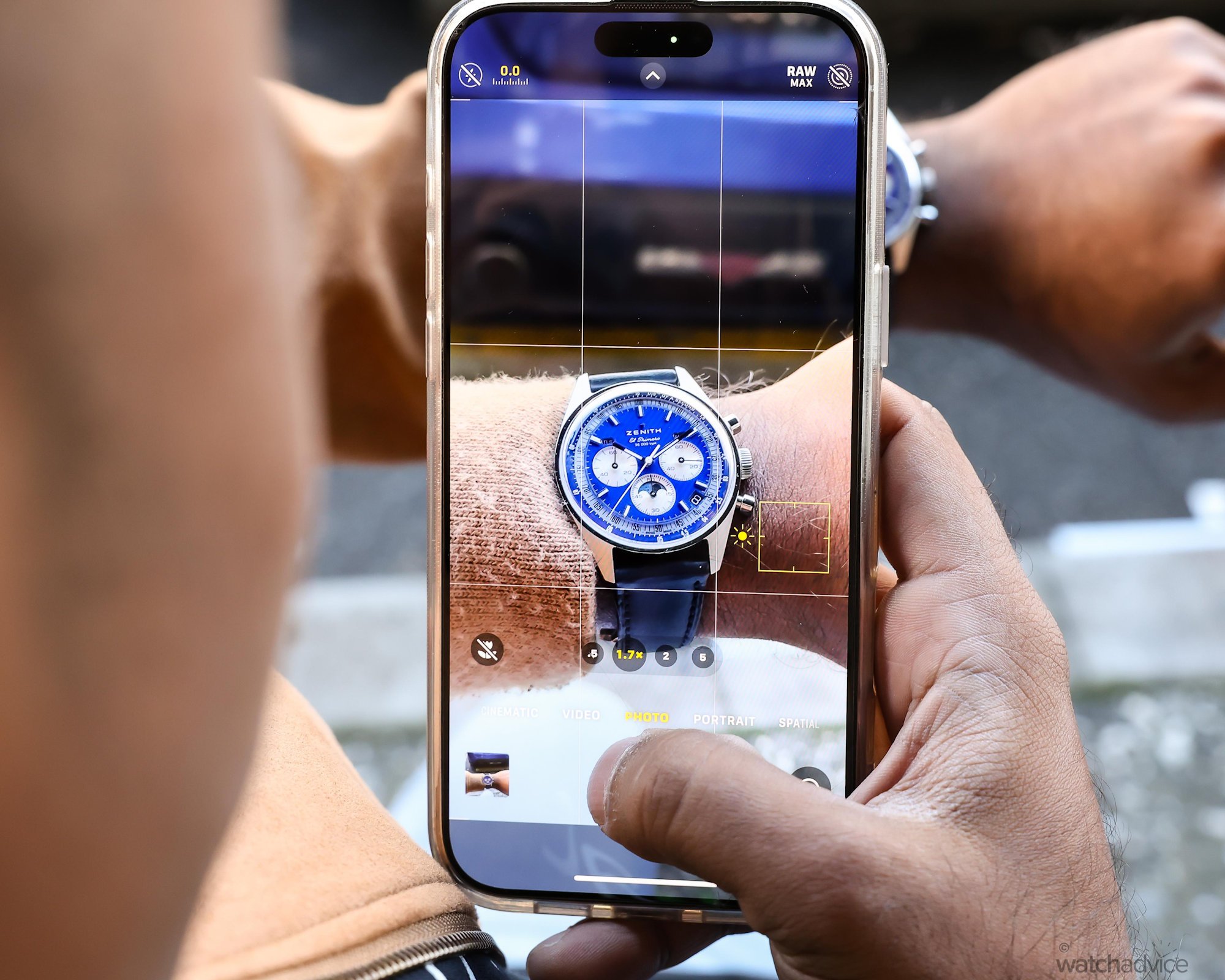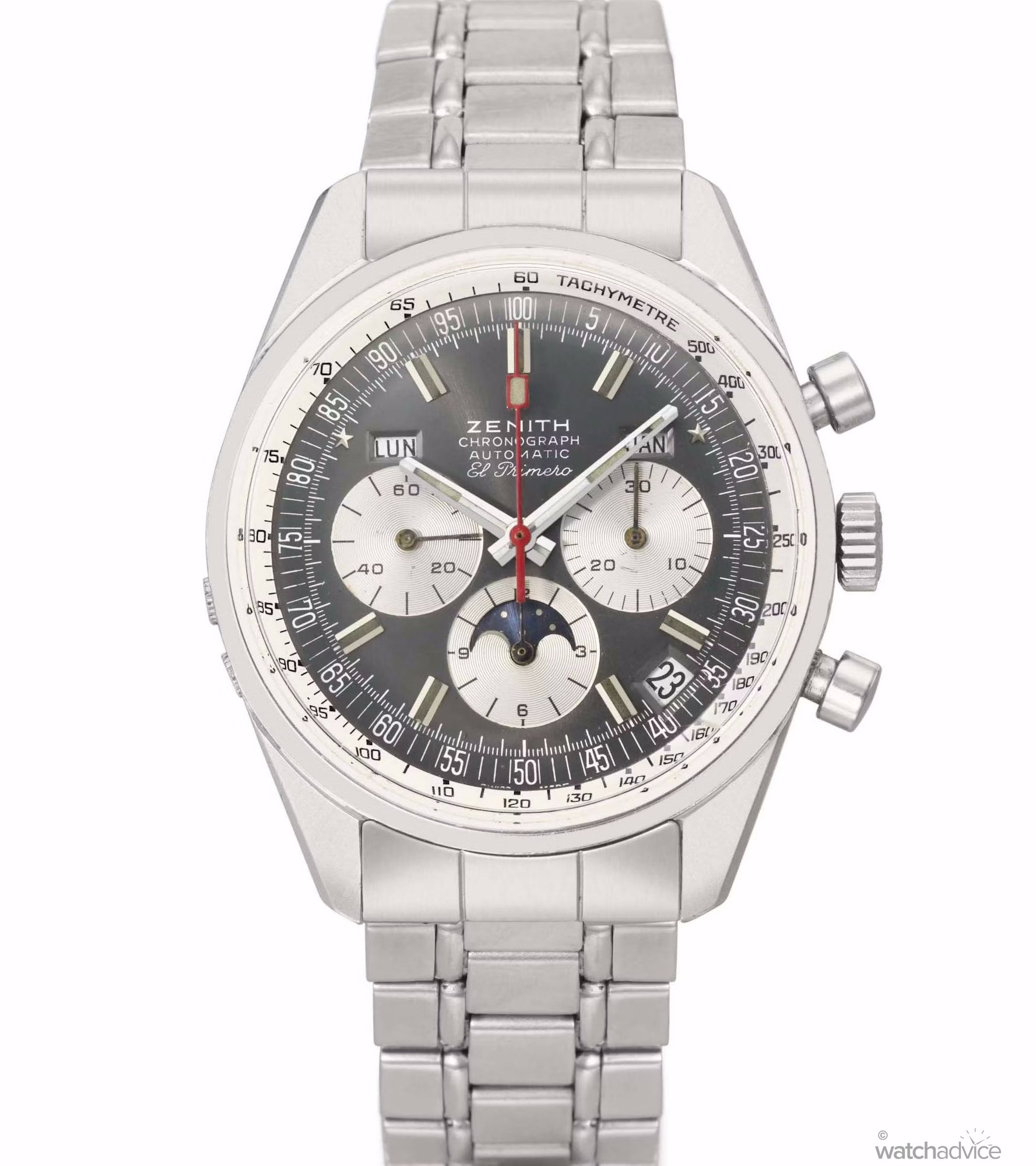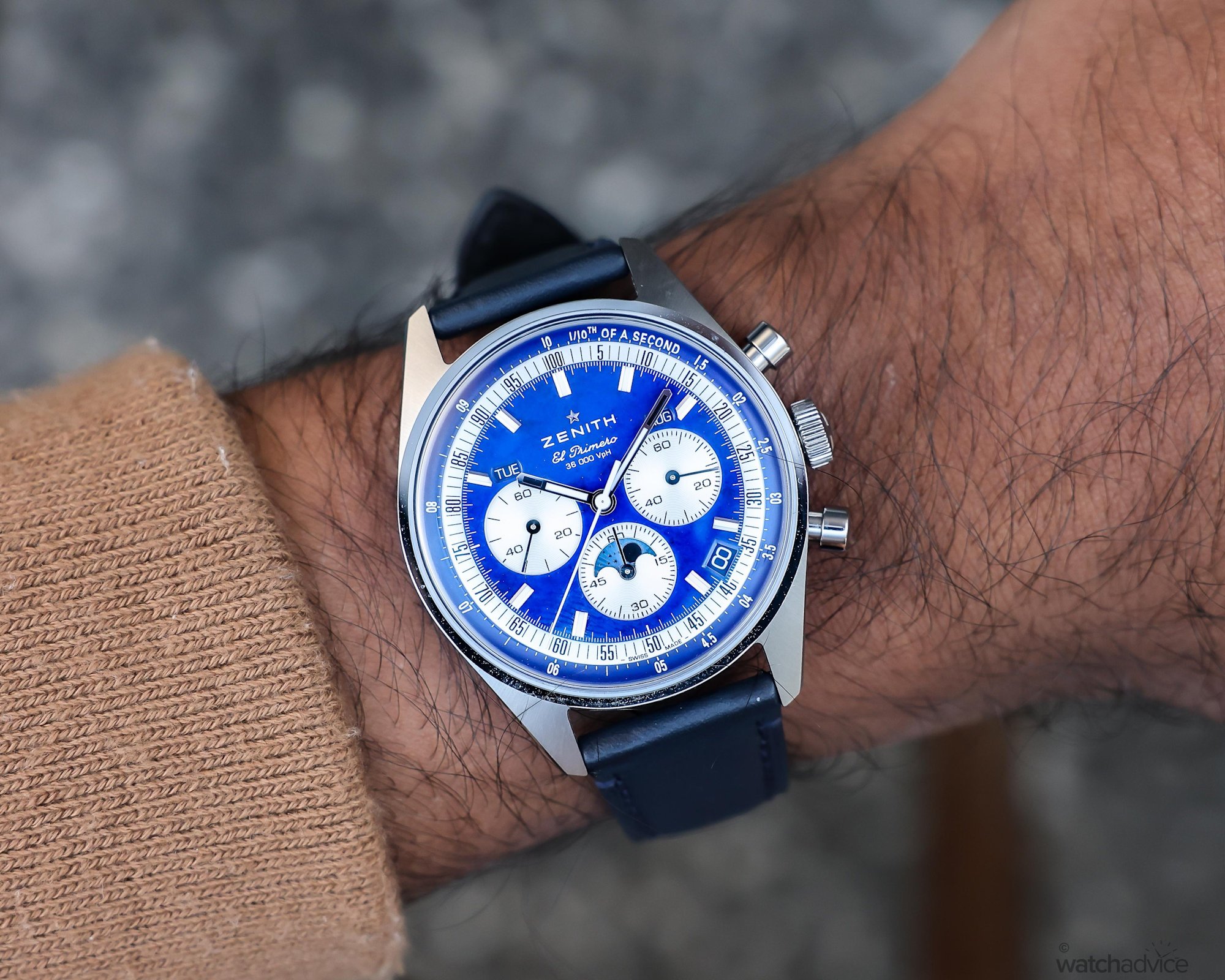A forgotten 1970s prototype finally brought to life, the Chronomaster Original Triple Calendar Lapis Lazuli is Zenith at its poetic best. A celestial twist on a historic design, this is a watch that feels as timeless as the night sky it represents!
What We Love
- The Lapis Lazuli stone dial is genuinely stunning. A vibrant, rich, and ever-changing under light, perfectly capturing Zenith’s celestial identity.
- The El Primero 3610 movement keeps the brand’s DNA alive with that iconic 36,000 vph beat and flawless integration of the triple calendar and moon-phase.
- Despite the dial’s visual complexity, the blue-and-white contrast and colour-matched calendar wheels keep everything clean, legible, and refined.
What We Don’t
- The straight lugs don’t curve down enough, meaning the case can sit slightly proud on smaller wrists.
- At 14 mm, it’s not overly chunky, but some may find it a little tall, especially under tighter cuffs.
- As a complete calendar, it still requires five manual date changes a year, not a deal-breaker, but something to note for practicality.
Overall Rating: 8.9/10
- Value for money: 8.5/10
- Wearability: 9/10
- Design: 9/10
- Build quality: 9/10
The story of the Zenith Chronomaster Original Triple Calendar is a fabled one, as it is about a timepiece that never made it to production, up until almost 54 years later, when Zenith went through their archives and found the original plans for this timepiece. While we can say that Zenith might’ve missed out on an incredible opportunity by not releasing the Chronomaster Original Triple Calendar back when it was meant to, I would argue that the brand is able to have a bigger impact by releasing the timepiece in the modern era that is now.
As you may be aware, especially through our very own articles, we have covered the Chronomaster Original Triple Calendar in quite a bit of detail, with Matt also doing a hands-on review on one of my favourite Zenith watches, the Chronomaster Original Triple Calendar with the olive green dial. Before we dive straight into the review of this latest dial variant, I feel that it’s important to give a refresher on the history of the collection, as it plays a pivotal role in understanding why this release is so significant.
As we know, Zenith in the 1960s set about developing a high-frequency (5Hz ~ 36,000 VpH) automatic chronograph movement, which would become the iconic El Primero movement. This movement was unveiled on January 10th, 1969, and it featured a remarkable design for its time, where it was created to be thin, an integrated design, and the ability to measure one-tenth of a second, a first of its kind for mechanical wristwatches.
While this high-frequency movement was being developed and put into production, the engineers at Zenith were already working in the background, trying to integrate more complications into the El Primero chronograph movement. This includes the full “triple” calendar display, which features the day of the week, date, and month, along with a moon-phase display. Zenith did come up design for this integration, and in 1970, created a small run of 25 prototypes that were produced using the round case of the famous Zenith A386 timepiece. These prototypes (given the reference name 1205SP) came fitted with the El Primero chronograph movement, now including the full triple calendar display along with a moon-phase display.
While this certainly presented a unique offering, whereby you have a very high-frequency movement (which was not at all common at the time), combined with additional complications, the prototypes never hit the Zenith production line, with the brand opting to shelve the design until later use. There are a variety of reasons why the Triple Calendar project was shelved. At the time of its inception, the market was hit with the quartz crisis, creating a difficult time for Swiss brands and automatic watchmaking in general. Releasing the prototype during this time could have proved to be a commercial risk, as demand for mechanical watches had plummeted in favour of more affordable, battery-powered alternatives. For Zenith, it made more sense to protect the El Primero’s legacy and focus on survival rather than expansion.
The production complexity of the Chronomaster Original Triple Calendar is something that also needs to be taken into account. The El Primero movement is highly complex in itself. It is an integrated chronograph operating at 36,000 VpH. We need to take into account that when Zenith introduced this movement, there was no automatic winding movement in the market at all prior. In fact, the brand was in a race against TAG Heuer, Breitling, and Hamilton-Buren to create the world’s first automatic chronograph. This “chronograph race” was one of the most important chapters in watchmaking history, and Zenith’s approach was markedly different.
Zenith’s El Primero was the standout chronograph movement, with the high-frequency (10 beats per second), making it not only the first chronograph, but also the first high-frequency automatic chronograph ever produced. So imagine then fitting this complex movement with a full calendar complication. It puts into perspective how complicated the production live would’ve been, especially to produce it in commercial quantities.
It was only recently that Zenith came across the plans of this now famous “shelved” project, which the brand then took the leap and put into production in 2024, recreating the original designs as it were, with a modern touch. Much can be said for introducing this timepiece earlier, as I personally think this could’ve been like Breitling’s Iconic Navitimer, as the dial features that complexity and visual intricacy that instantly draws you in. The combination of the triple calendar, moon-phase display, and high-frequency chronograph would have given Zenith an unmistakable icon of its own in the 1970s.
Yet, in a way, the delayed release adds to its legend. By finally revisiting the shelved project in 2024, Zenith has done more than just reissue an old prototype; it has brought to life a watch that bridges two eras of innovation. Since its “re-introduction,” the collection has grown rapidly, with various coloured dials and case materials to help enhance the already existing stunning complex look of this collection.
Initial Thoughts – Zenith Chronomaster Original Lapis Lazuli
For the 2025 rendition of the Chronomaster Original Triple Calendar, Zenith is showcasing its signature blue colour as the brand celebrates its 160th anniversary. Zenith released a host of timepieces this year using this deep, vibrant blue hue, a colour that is reserved by the brand for only special releases, and special this certainly is, as it celebrates 160 years of beautiful watchmaking is no small feat.
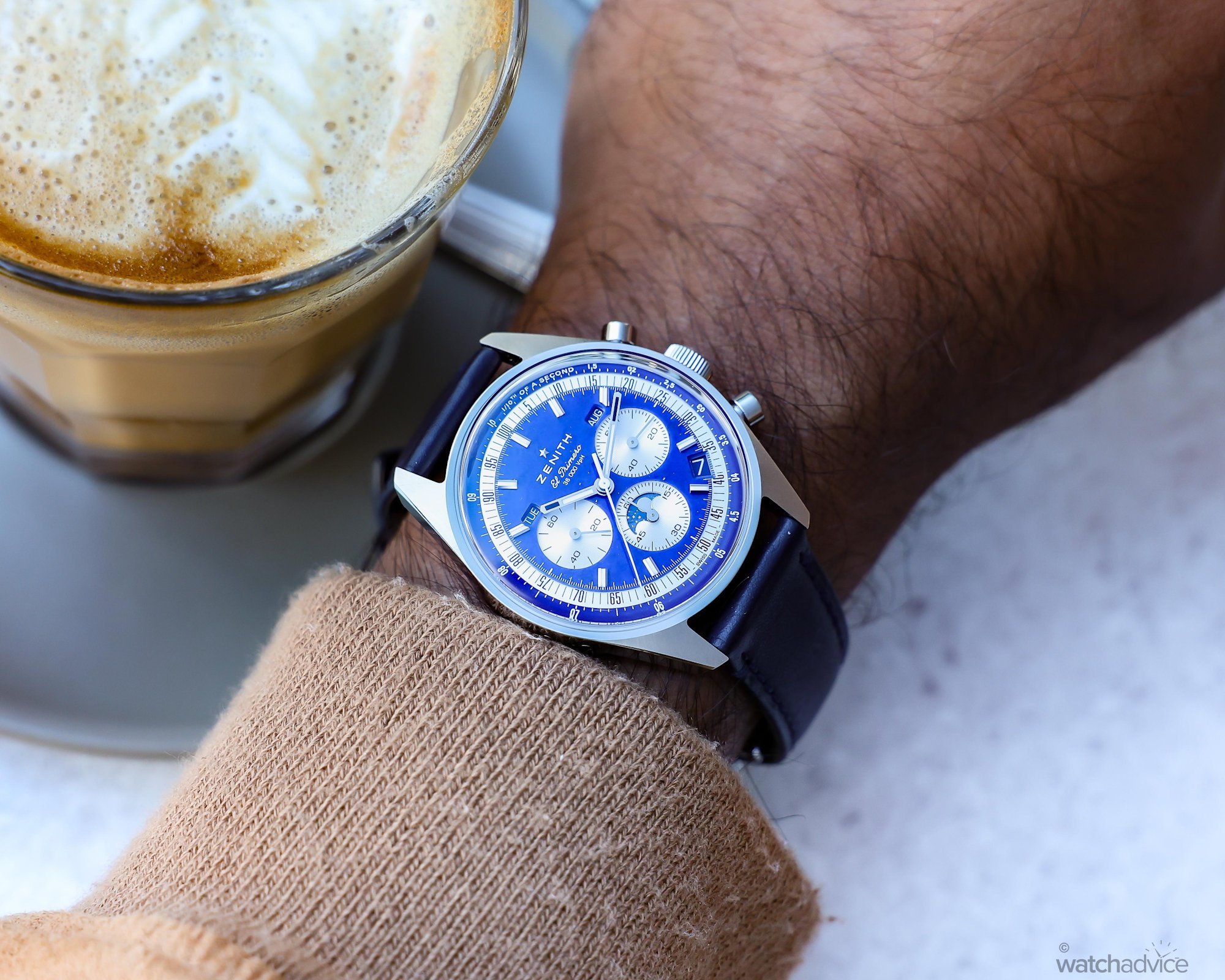
When Zenith unveiled the 160th anniversary editions earlier in the year during Watches & Wonders, there was two timepieces that immediately stood out to me. The first was the DEFY Skyline Chronograph in full blue ceramic, and the second was this stunning Chronomaster Original Lapis Lazuli. Fortunately, I was able to get both watches for review, and what can I say besides the fact that I absolutely loved my time with both watches. I’ll be honest—before even trying the Chronomaster Original Lapis Lazuli, I already had a soft spot for it. Ever since seeing the olive green dial variant, I knew this model had something special, so expectations were high going in. And the fact that I personally love the colour blue, particularly this deep, vibrant royal blue shade, didn’t help matters either!
Case Design Chronomaster Original Lapis Lazuli
When Zenith designed the modern rendition of the Chronomaster Original Triple Calendar from the original plans, they wanted to keep it as close to the original designs as possible. As mentioned earlier, the prototype models of the Chronomaster Original Triple Calendar took the A386 case design, which featured a circular silhouette with vintage chronograph “pump” pushers, along with the angled, sharp lug design.
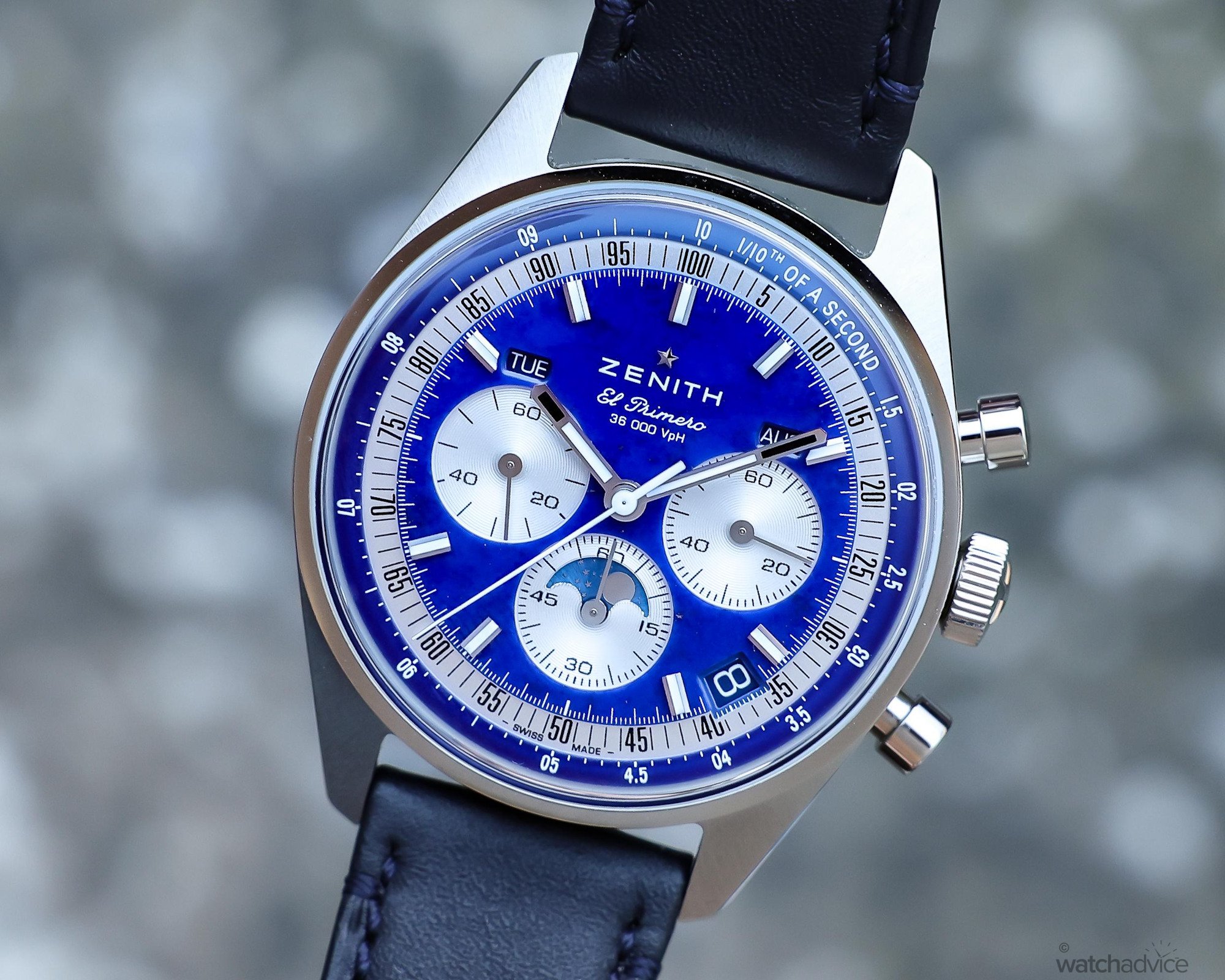
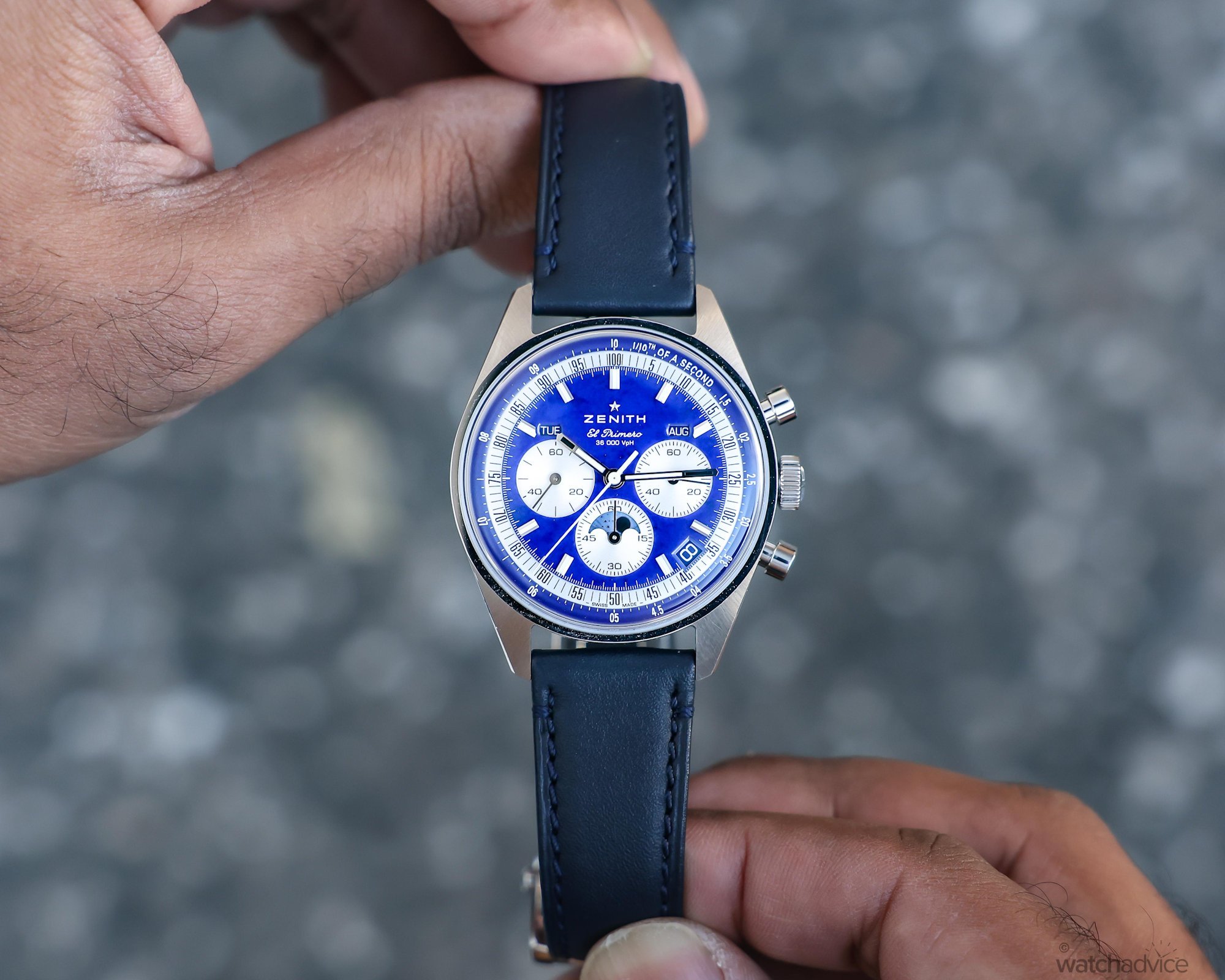
This has all been retained in the 2024 modern release, with refined finishes such as satin-brushed surfaces, polished case sides, polished bezel, and polished chronograph pushers to give it that luxury aesthetic. The 38mm stainless steel case is a great size, which helps it fit on the wrist better, as the lugs, even though they are sloped, are quite elongated. The case is 14mm thick, and while that is on the larger side, this can be forgiven considering the complexity of the movement sitting inside.
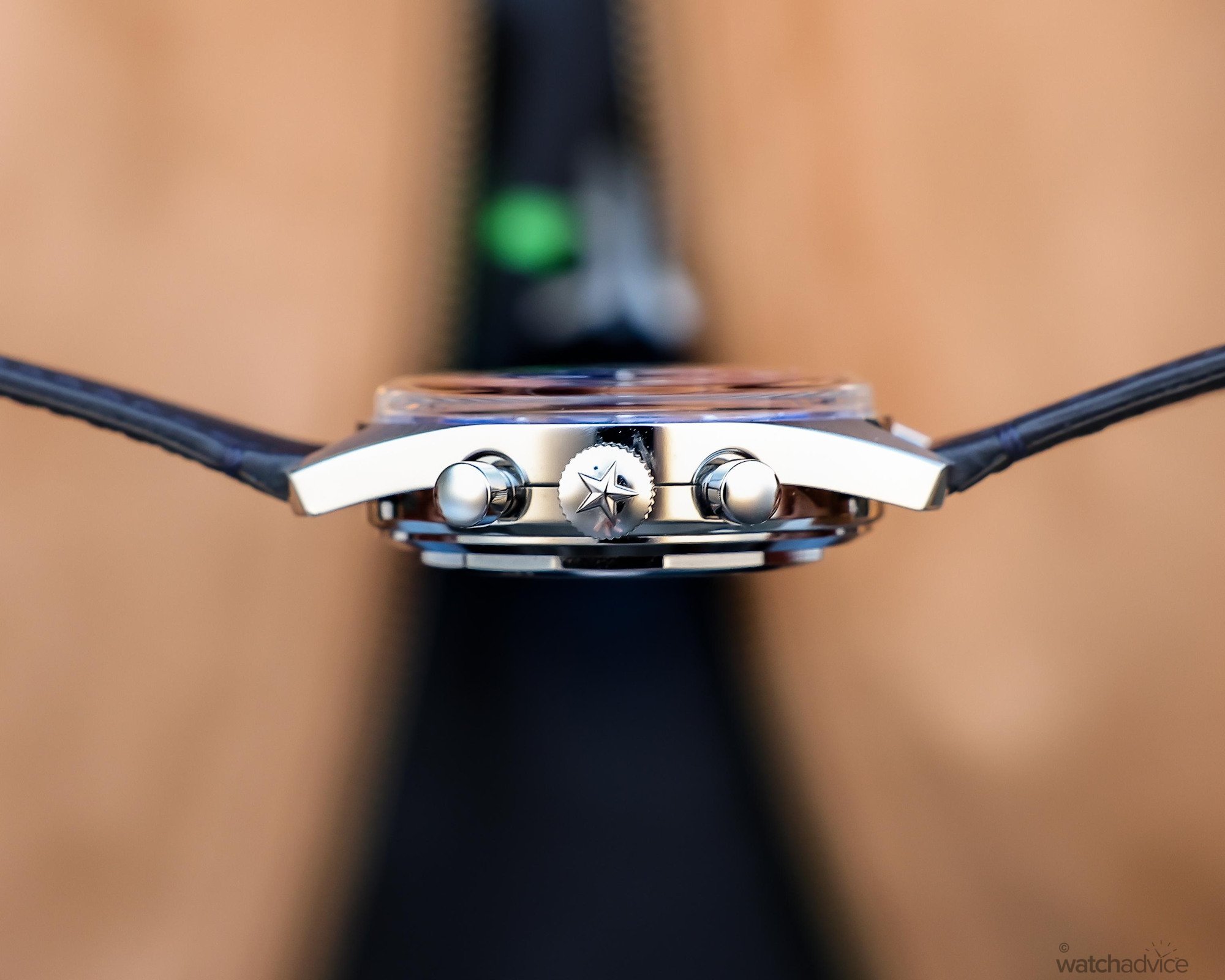
The case stays true to the 1970 prototype but with subtle refinements for modern standards. The only downside I’ve noticed, though, is in the curvature of the lugs. At around 14mm thick, the case isn’t overly chunky, but the lugs extend straight out rather than curving down, which means they sit slightly above the wrist instead of hugging it. You really notice it from the side profile. It’s not uncomfortable, just not as naturally contoured as it could be. While I appreciate Zenith’s dedication to preserving the original proportions, a bit of modern reworking on the lug geometry would’ve made it sit even better on the wrist. Still, it’s a small trade-off for a design that otherwise nails the blend of heritage and refinement.
Dial Design Chronomaster Original Lapis Lazuli
Zenith has featured the Lapis Lazuli dial in some of their other 160th anniversary timepieces, such as the revamped DEFY Zero G and the new G.F.J timepiece, so this isn’t a completely new venture for the brand. On the Chronomaster Original Triple Calendar, the Lapis Lazuli fits in perfectly without making the dial seem overly complicated or crowded with too much detail. It maintains the familiar layout of the triple calendar while giving it an entirely new personality through the deep, natural blue of the lapis.
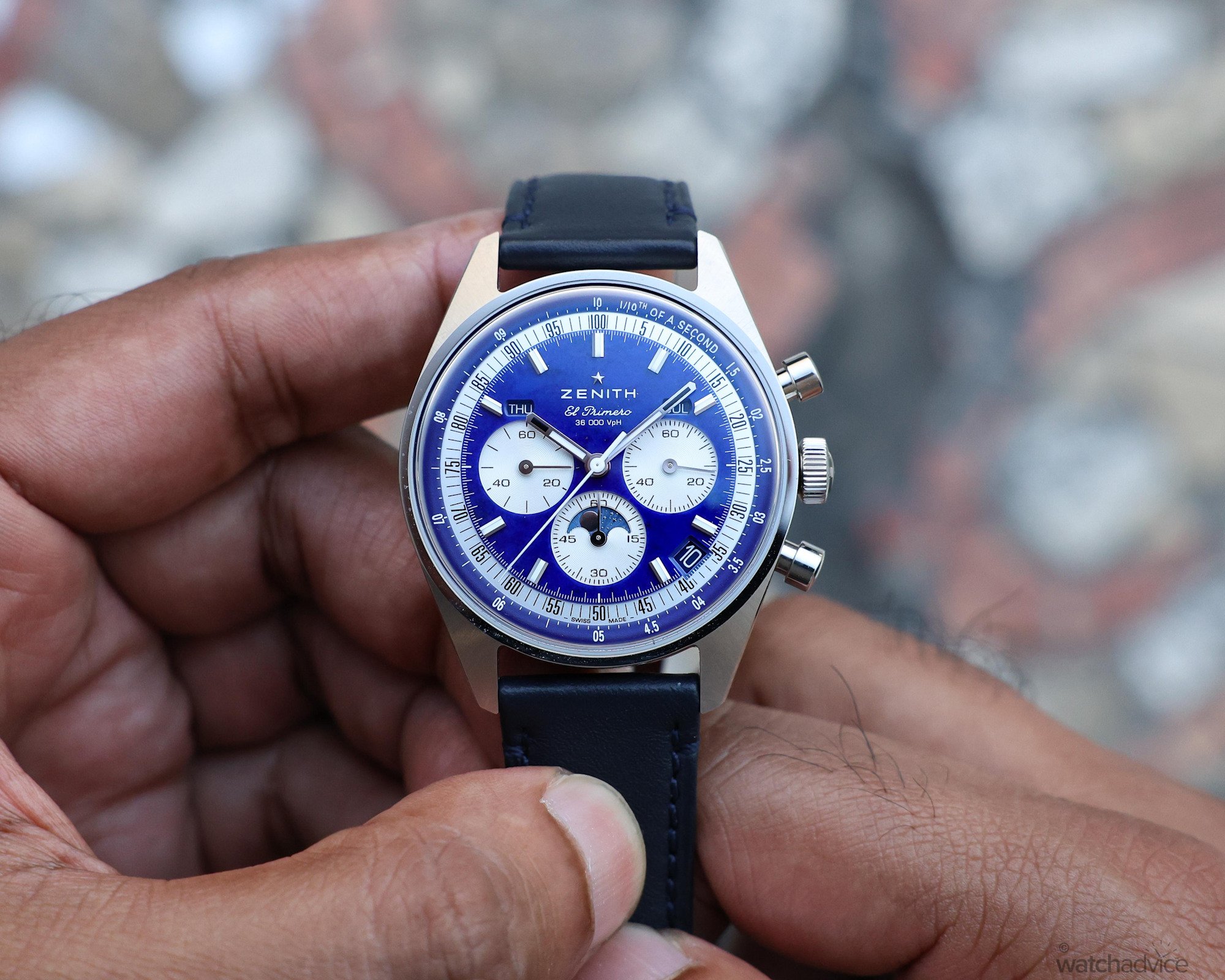
If you may be wondering why this version of the Chronomaster Original Triple Calendar is offered at a premium price, it’s due to this Lapis Lazuli dial. While the stone isn’t as rare as some gemstones, it is still hard to source, with only a handful of mines around the world providing this beautifully coloured stone. The primary source for the stone comes from Afghanistan; however, stones from this region are known for having fewer pyrite inclusions. Other sources include mines from Russia, Chile, Canada, Siberia, and Myanmar etc. Stones from Russia and Siberia are known to have more pyrite inclusions, which Chronomaster Original Triple Calendar Lapis Lazuli has, in the form of “Shimmering, gold-toned pyrite” that, as Zenith states, “gives the image of evoking the starry night sky and adds unique details to each piece”.
This image of a “starry night sky” on the dial is quite fitting, given the brand’s name, Zenith, which literally refers to the highest point in the heavens. Under certain light, the natural flecks of pyrite embedded in the lapis shimmer like distant stars scattered across space. It’s one of those dials that constantly changes depending on the lighting conditions: vibrant blue under the sun, mysterious and cosmic indoors. It captures that sense of wonder and celestial beauty that’s always been part of Zenith’s DNA!
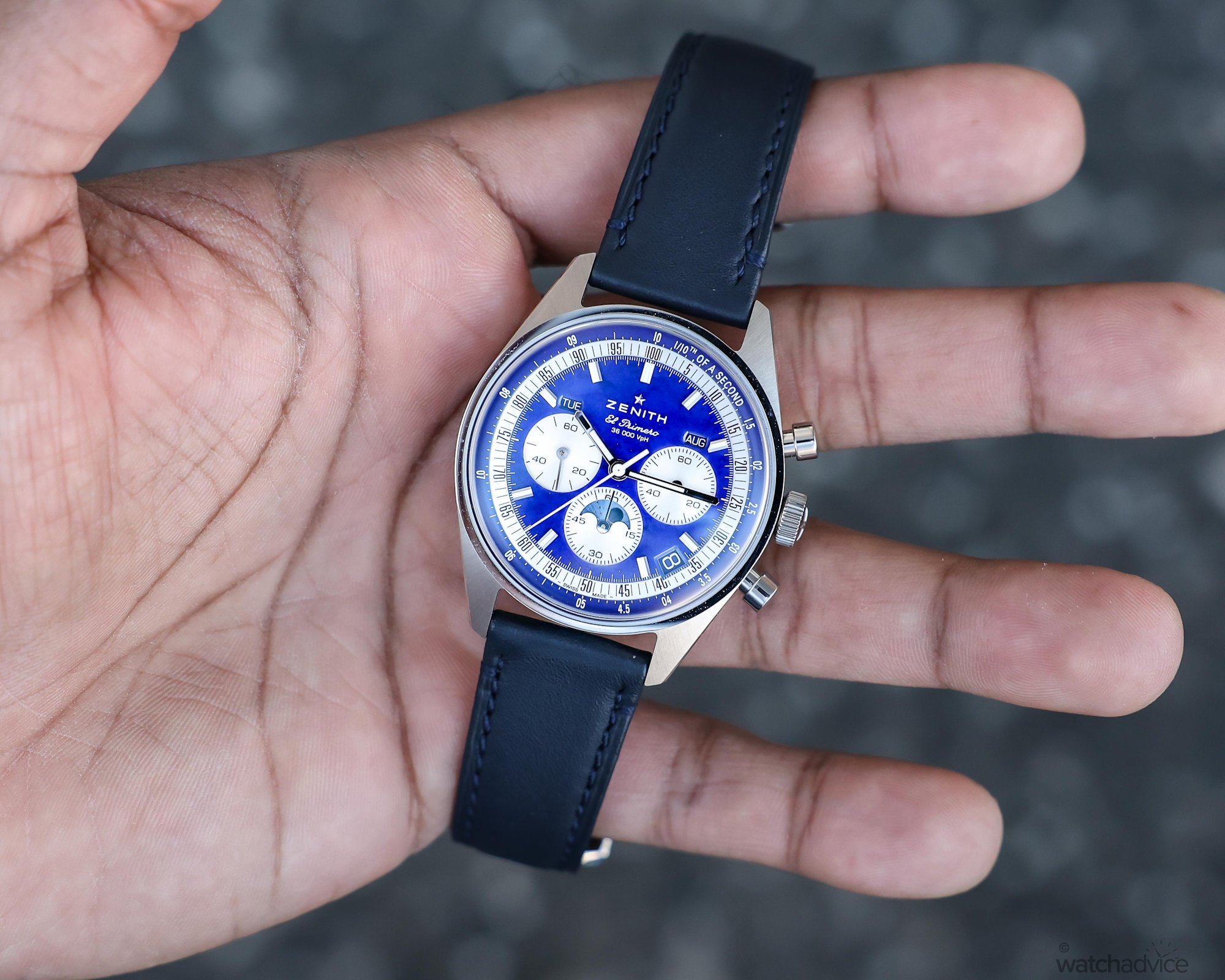
The design of the Chronomaster Original Triple Calendar is carefully thought out so that it naturally integrates with the chronograph sub-dials, leaving the dial relatively clean and easy to read, whilst also letting that Lapis Lazuli dial command the attention. First, we have the date complication between 4 and 5 o’clock, the day-of-the-week at 10 o’clock above the 9 o’clock constant seconds sub-dial, and lastly the month complication shown at 2 o’clock, sitting just above the 60-second counter at 3 o’clock. I like how Zenith has reduced the size of the apertures of the day-of-the-week and month indications to reduce the overall complex “appearance” of the dial.
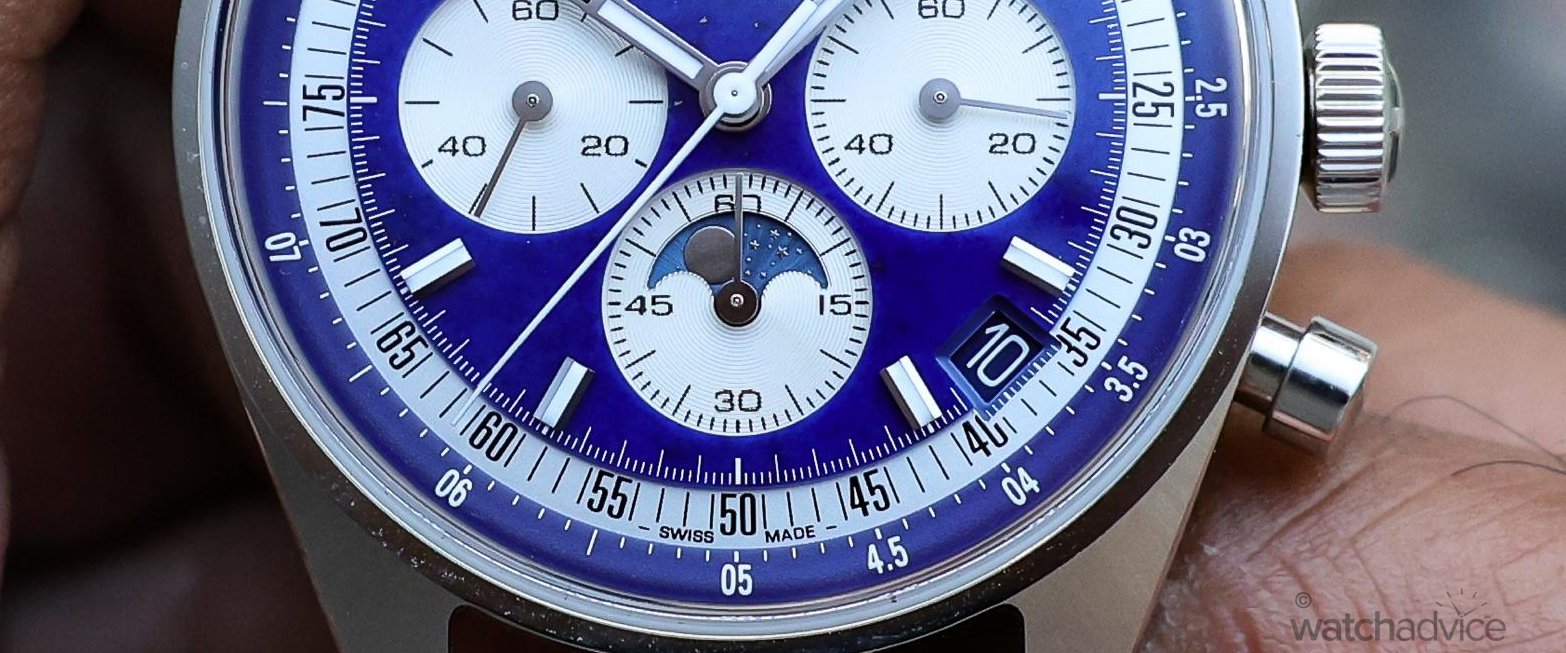
Aside from the Lapis Lazuli dial, the moon-phase display is another captivating detail. Set within the 6 o’clock sub-dial, the moon-phase features a fine-textured sky-blue disc that is adorned with tiny, polished stars that shimmer against the backdrop, perfectly tying into the celestial theme of the Lapis Lazuli dial. The moon itself is rendered in a silver tone, half-hidden behind curved, cloud-like engravings. What makes this a beautiful highlight of this stunning dial is how the moon-phase sits at the heart of a dial, one that is already inspired by the night sky. A literal reflection of time and space.
El Primero Calibre 3610 Movement
The calibre inside Zenith’s latest Chronomaster Original Triple Calendar collection is the result of 50 years of continuous development of one of the best chronograph movements in the industry. This is the latest version of the El Primero movement, operating at a very high frequency of 5Hz (36,000 VpH). This movement also features the 1/10th of a second chronograph function, meaning the chronograph hand makes a revolution around the dial once every 10 seconds, instead of the usual 60 seconds per revolution. This is possible thanks to the El Primero movement operating at 5Hz, which allows the movement to split into 1/10 of a second increments.
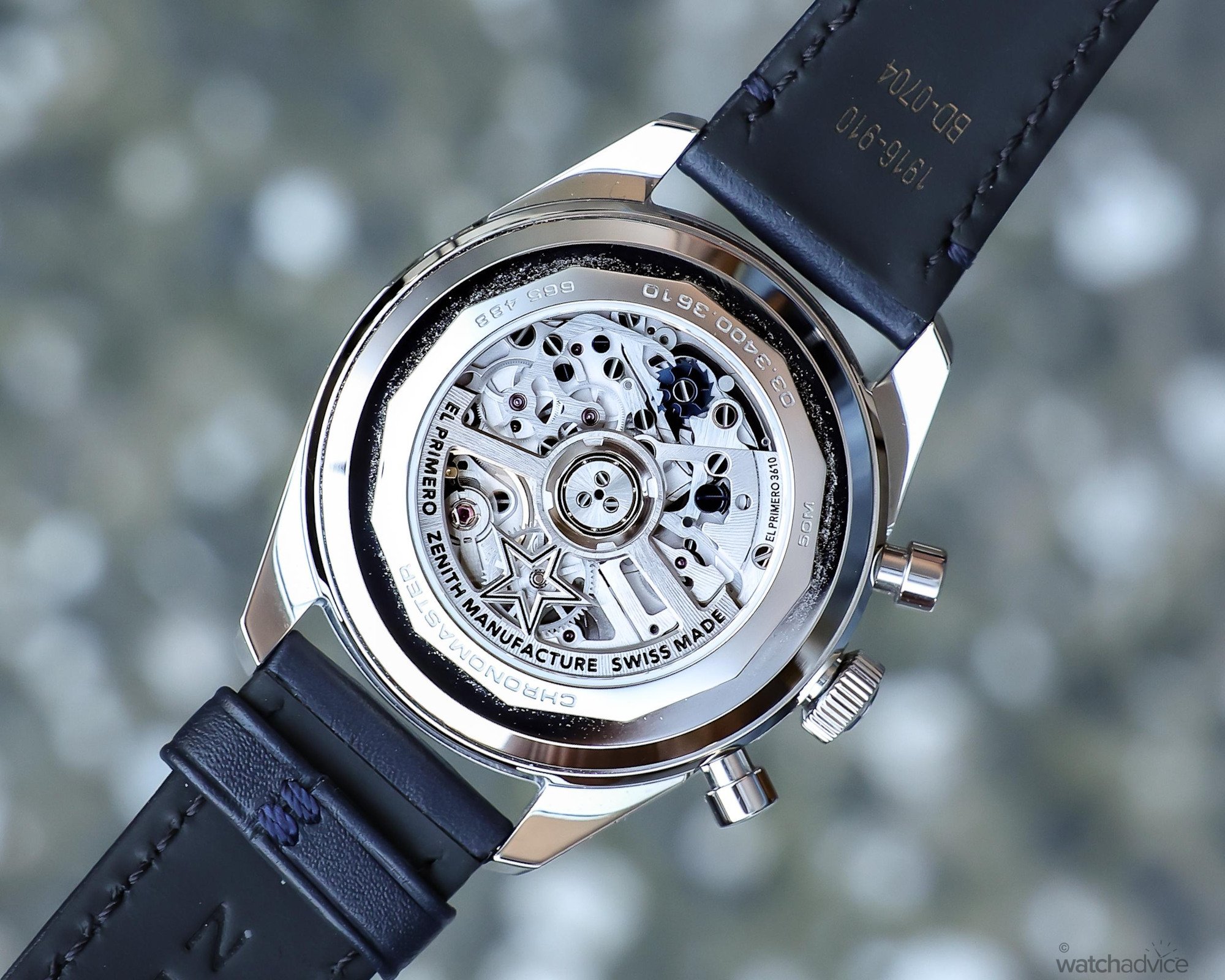
Flip the watch over, and the caseback is almost as impressive as the front. Through the sapphire exhibition window, you get a clear view of the El Primero Calibre 3610. The movement has been beautifully finished, with the rotor featuring Zenith’s iconic 5-pointed star logo, and is skeletonised to give a view of the various finishings underneath. I personally love that most of the movement is visible and is not hidden away by plates. The Côtes de Genève striping across the bridges, perlage on the main plate, and the various jewels give the movement a real sense of depth and craftsmanship. Each element catches the light differently, drawing your eyes deeper into the calibre.
How Does It Wear?
With a 38mm case size and lug-to-lug distance of just 46mm, the Zenith Chronomaster Original Triple Calendar Lapis Lazuli was always going to be a watch that wears well on the wrist. The proportions hit just the right spot, presenting a watch that is balanced, versatile, and easy to wear on a daily basis. The only real point of contention is the 14mm thickness, but honestly, I got used to it pretty quickly. I prefer watches with more presence on the wrist, so that extra bit of height and weight gives it a solid, confident feel on the wrist, rather than being a drawback.
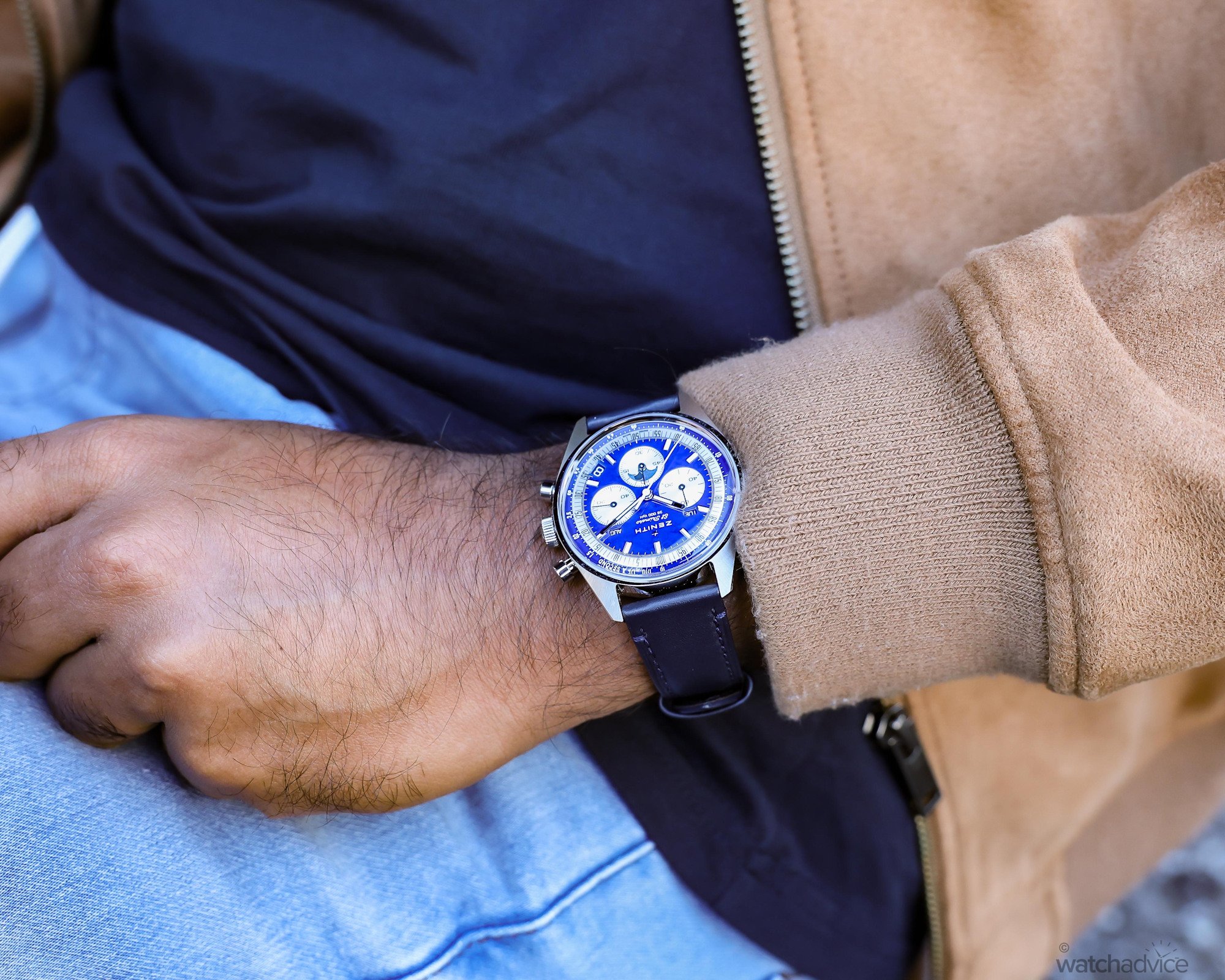

The blue and white colour combination, a personal favourite of mine, plays another major role in the timepiece’s overall wrist presence. The rich, deep blue of the Lapis Lazuli dial contrasts beautifully against the crisp white sub-dials, making all the indications clear and easy to read at a glance. The silver, circular-snail sub-dials add an extra layer of texture and reflect light differently depending on the angle; it’s that kind of small detail that keeps the dial visually engaging. I also love that the triple-calendar apertures have colour-matched wheels, helping them blend seamlessly into the dial rather than breaking up the visual harmony.
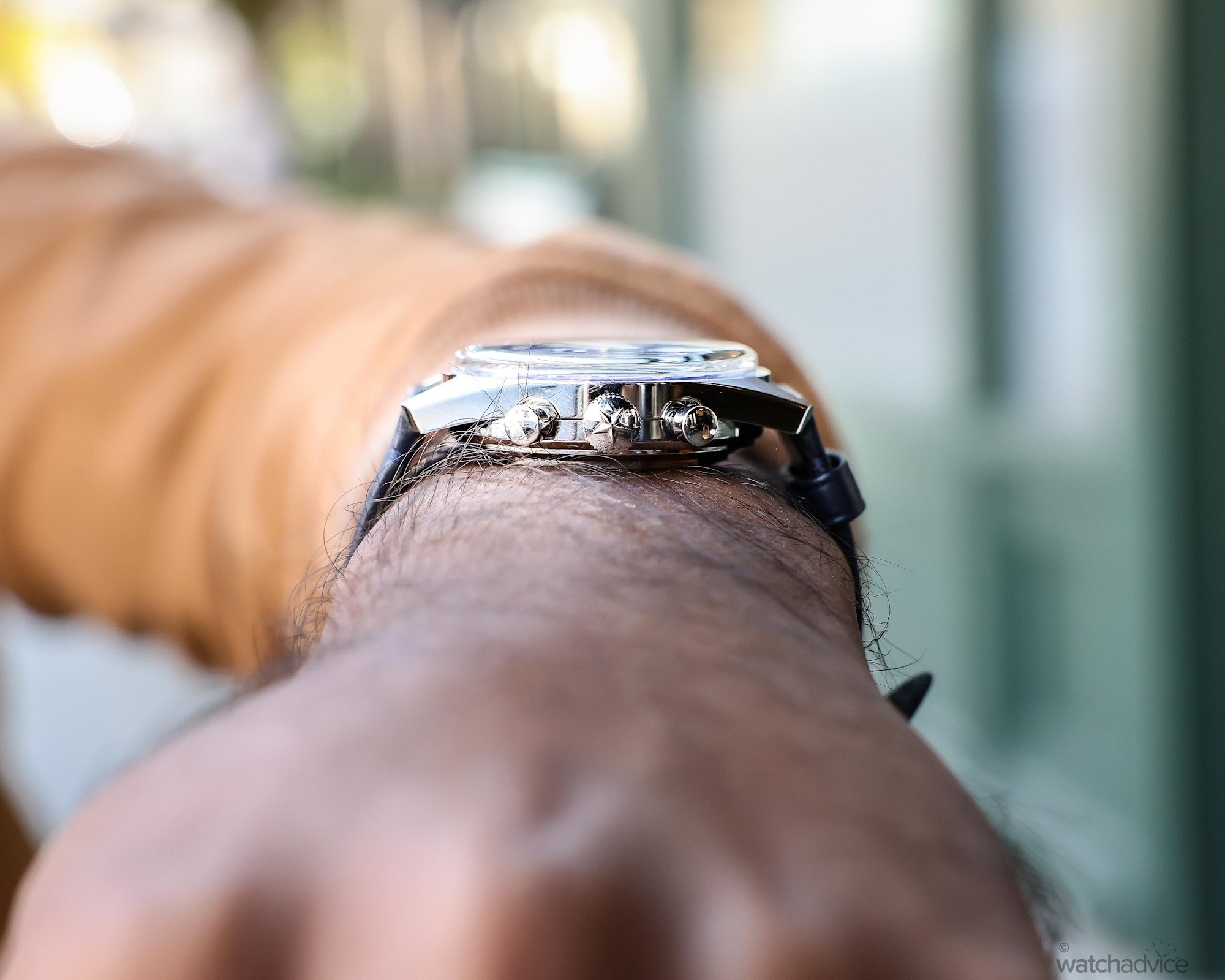
While the case is an iconic design that honours Zenith’s history, I do think it could’ve benefited from a few modern ergonomic tweaks. If the lugs were angled down just a bit more, it would hug the wrist more naturally, especially for those with smaller wrists. That said, comfort overall is excellent, and it’s hard not to appreciate the craftsmanship and balance Zenith has achieved here. And since the dial is cut from natural Lapis Lazuli stone, no two watches will ever be the same. Every slice has its own unique inclusions and texture, making each piece a true one-of-a-kind!
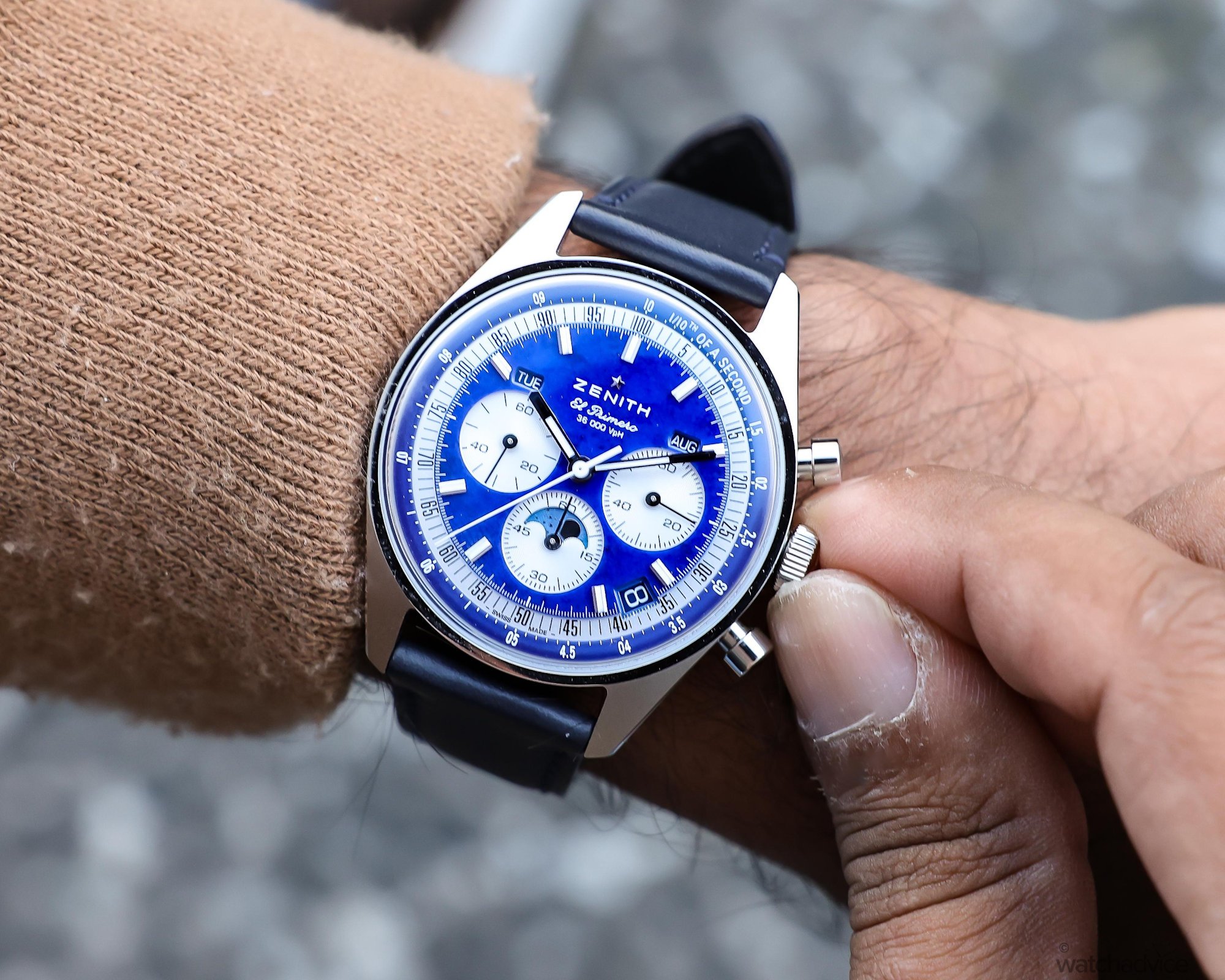
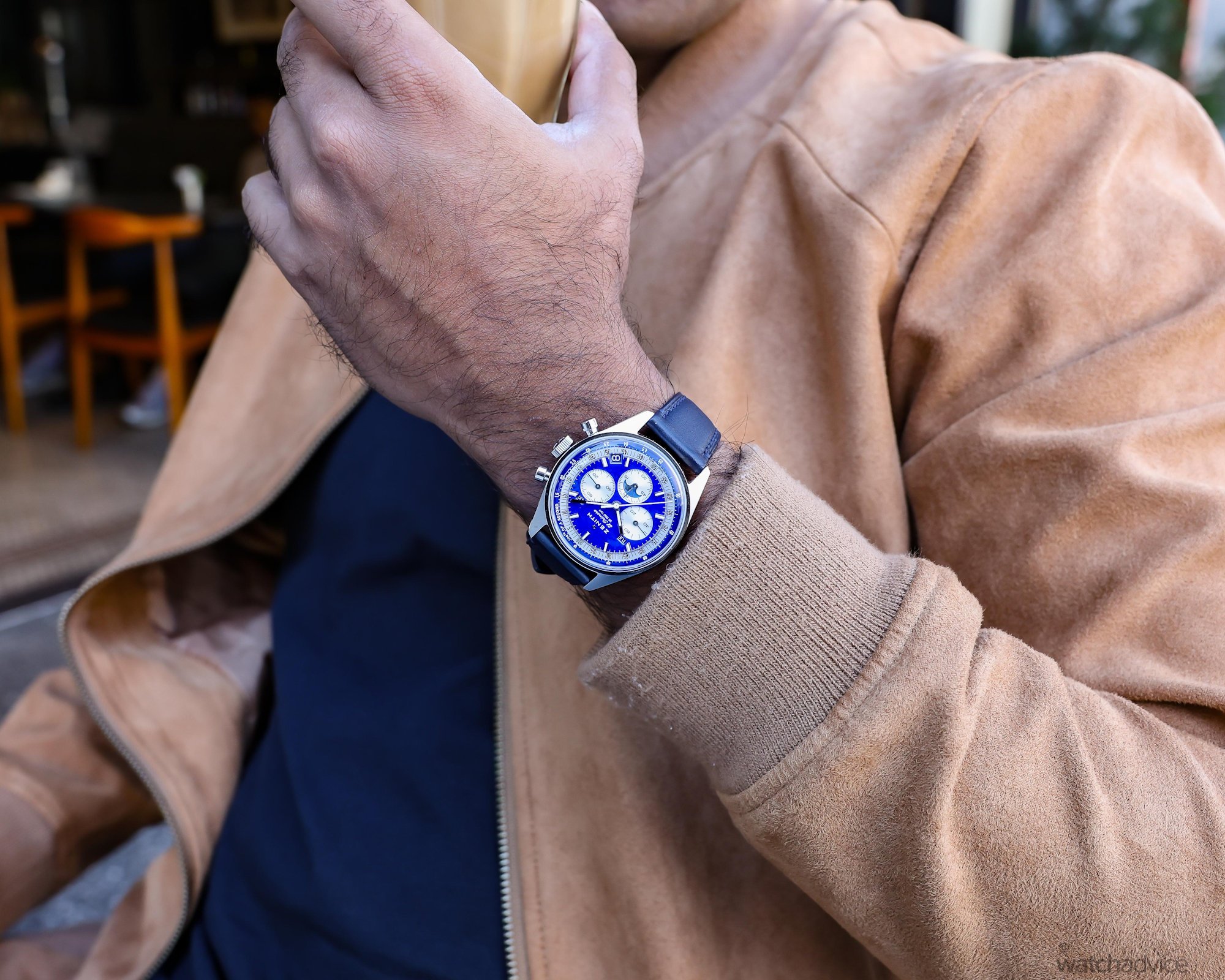
As the watch is a complete (triple) calendar, the watch will need a bit of manual adjustment throughout the year, five times to be exact. February, April, June, September, and November. There are two recessed pushers on the left side of the case to allow for quick setting of the day of the week and moon phase. The crown’s first position adjusts the date and, in turn, the month. It’s intuitive, practical, and true to Zenith’s fashion of being executed with precision.
Final Thoughts On The Chronomaster Original Lapis Lazuli
The Chronomaster Original Lapis Lazuli feels like a perfect example of Zenith being at its very best. Bringing together heritage, innovation, and emotion all in one stunning watch. The whole Chronomaster Original Triple Calendar collection is a nod to Zenith’s most fascinating “what-if” projects from the 1970s, now finally seeing the spotlight. This latest variant, however, adds a completely new character to the collection, marrying the timepiece’s highly precise movement with a dial that is as artistic as it is technical.
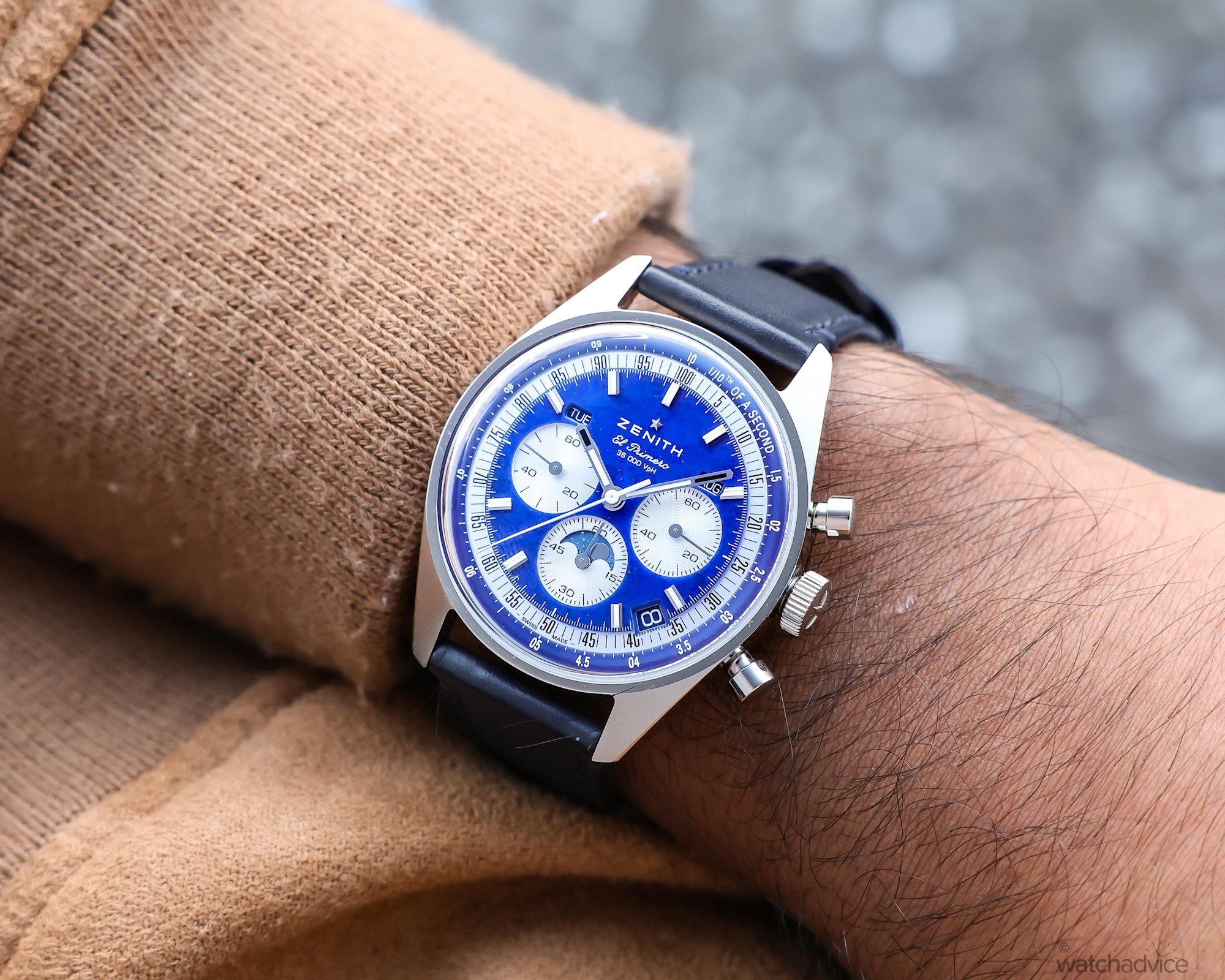
What makes the Chronomaster Original Lapis Lazuli really stand out is how beautifully the lapis dial interacts with the rest of the design. The contrast between the deep blue stone and the crisp silver sub-dials makes every function easy to read, yet it never loses that poetic connection to the stars. A theme that runs deep in Zenith’s DNA. Paired with the moon-phase display and high-frequency El Primero calibre beating beneath, it’s a perfect blend of mechanical brilliance and celestial charm. It feels less like a watch that tells time through the stars.
Overall, I see the timepiece as Zenith bridging the past and the present in a way very few brands are able to pull off. The Chronomaster Original Lapis Lazuli celebrates Zenith’s technical legacy while offering something that is visually daring and emotionally engaging. Sure, a few modern refinements to the case geometry would’ve made it even better, but that doesn’t take away from what this watch represents: a completion of a long-shelved dream and a reminder of why Zenith continues to stand among the true icons of Swiss watchmaking!
Specification: Zenith Chronomaster Original Lapis Lazuli (Ref. 03.3400.3610/51.C910)
- Dimensions: 38mm x 14mm thick x 46mm lug-to-lug distance
- Case Material: Stainless steel with a mix of polished and satin-brushed surfaces.
- Dial: Lapis Lazuli dial with silver circular snaliled chronograph counters. 1/10th of a second chronograph functionality with complete (triple) calendar and moon-phase complication.
- Water Resistance: 50m (5 Bar)
- Movement: Automatic winding El Primero Calibre 3610
- Movement Power reserve: 60 hours operating at 5Hz (36,000 VpH)
- Crystal: Sapphire with anti-reflective coating
- Bracelet/Strap: Dark blue leather strap


